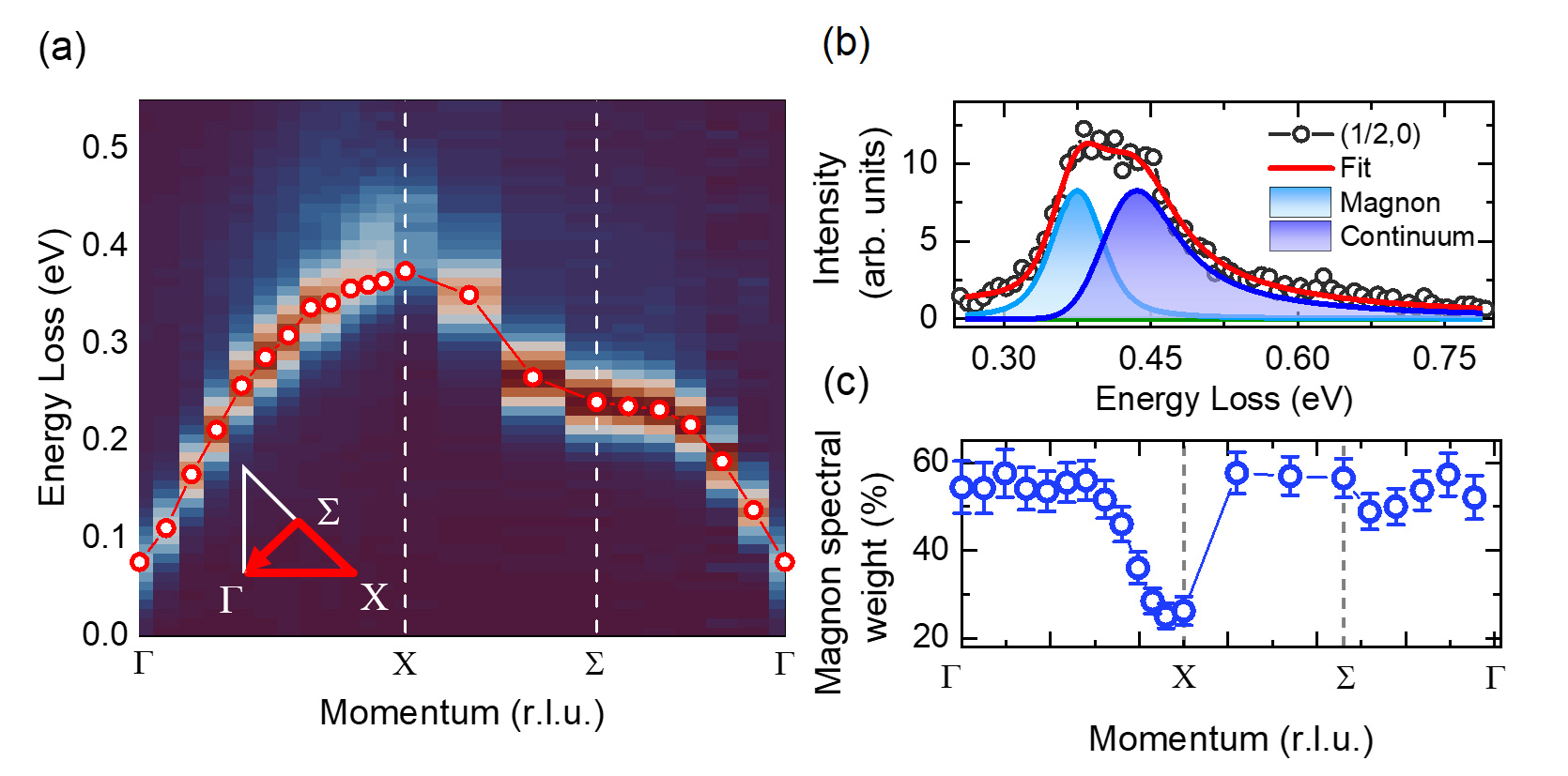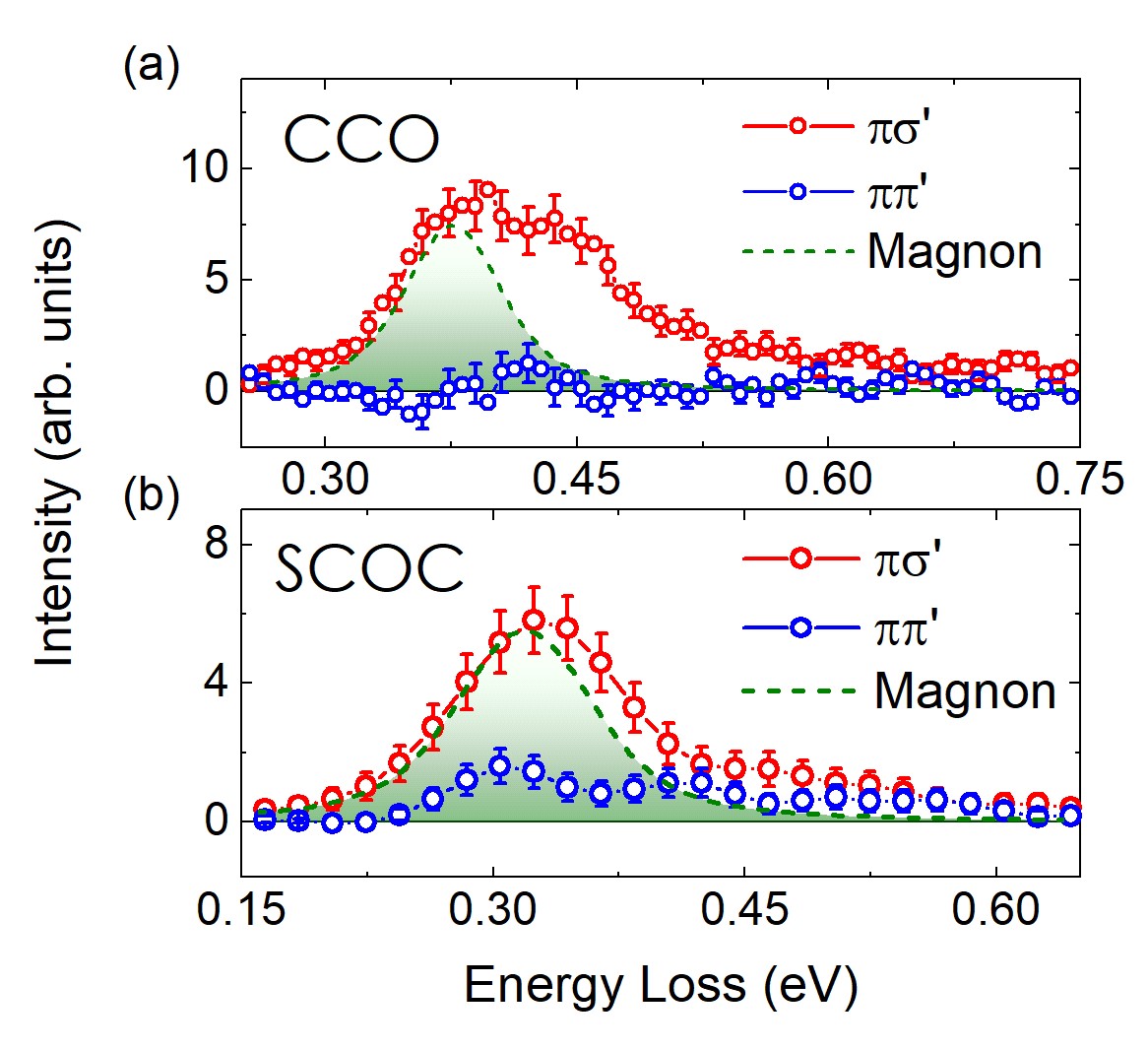- Home
- News
- Spotlight on Science
- Identifying fractional...
Identifying fractional spin excitations in a 2D cuprate
04-07-2022
The 2D antiferromagnetic square-lattice is the scaffold of high Tc superconductivity in cuprates and collective spin excitations are its fingerprint. RIXS measurements at beamline ID32 reveal that, in CaCuO2, the usual magnons can break into pairs of spinons, due to multi-spin exchange interactions.
High-temperature superconducting cuprates share a fundamental building block: CuO2 layers arranged in a square lattice, each site having spin-1/2 and interacting with neighbouring ones through strong antiferromagnetic (AF) couplings. While the magnetic structure is simple, the physics behind it is still not completely understood.
In most cases, long-range AF order is stabilised and the elementary excitations are described in terms of bosonic spin waves (or magnons), carrying spin 1. However, different models predict a fragility of this system against large next-nearest neighbour or multi-spin couplings [1]. Even in the absence of geometric frustration, such instabilities can drive quantum phase transitions towards different kinds of quantum spin liquid. The fingerprint of such transitions is the fractionalisation of the usual spin waves into pairs of fermionic excitations (i.e., 2-dimensional spinons). Indeed, fractionalisation is characteristic of 1D-spin chain systems but is not incompatible with 2D long-range AF order. Although in cuprates inelastic neutron and X-ray scattering had detected anomalies in the magnetic spectra [2], no definitive evidence of fractionalisation had been found so far, due to the difficulty of distinguishing pairs of spinons from other types of magnetic excitations (e.g., multi-magnons).
Resonant Inelastic X-ray Scattering (RIXS) was used at beamline ID32 to investigate the magnetic spectrum of the infinite-layer cuprate CaCuO2 (CCO). In this material, the absence of apical oxygens enhances both the nearest-neighbour J and the longer-range super-exchange interactions with respect to other cuprates [3]. As a result, the multi-spin interaction known as “ring exchange” Jc is very large too.
Click image to enlarge
Fig. 1: a) Momentum-dependence of the magnetic excitations in CaCuO2, measured along the path depicted in the inset. b) RIXS spectrum at the X point (1/2,0). Red curve is the result of a fitting. The light-blue curve is a Voigt profile representing the magnon, while the deep blue one fits the putative two-spinon continuum. c) Ratio between the magnon spectral weight and the total magnetic spectral weight as a function of momentum along the same path of panel (a).
The evidence of fractionalisation of magnons can be seen in the Brillouin-zone map of Figure 1a. The sharp spin-wave peak, dispersing across most of the Brillouin zone, breaks into a continuum of high-energy states when approaching the antinodal point X. Such continuum shows a broad energy bandwidth, as shown in Figure 1b, and carries the majority of the magnetic spectral weight (Figure 1c).
Click image to enlarge
Fig. 2: a) Polarisation-resolved spectrum of CCO at the X point. Red is the spin-flip channel, while blue is the spin-conserving one. The green curve is a Voigt curve fitting the magnon profile. b) Same spectrum on Sr2Cu2OCl2.
To unravel its nature, the unique capabilities of the ERIXS spectrometer were employed, including ultrahigh energy resolution (26 meV at the Cu L3 absorption edge) and the soft X-ray polarimeter, which allows to disentangle spin-flip and spin-conserving excitations. Their polarisation dependence reveals a dominant spin-flip character (Figure 2a), which, together with their incident-energy behaviour, rules out a more trivial multi-magnon origin. As a comparison, Figure 2b shows the corresponding spectrum in Sr2CuO2Cl2 (SCOC), which has a much smaller ring exchange Jc than CaCuO2. In SCOC, the magnon peak is the dominant excitation even at the X point. Therefore, sound evidence links such anomaly in CCO to a two-spinon continuum, and correlates its presence with an exceptionally high Jc∼J.
This work confirms that in the CuO2 planes of cuprates, long-range antiferromagnetism can coexist with spin-glass phenomena and paves the way for future RIXS studies on quantum magnetism.
Principal publication and authors
Fractional Spin Excitations in the Infinite-Layer Cuprate CaCuO2, L. Martinelli (a), D. Betto (b), K. Kummer (b), R. Arpaia (c), L. Braicovich (a,b), D. Di Castro (d,e), N.B. Brookes (b), M. Moretti Sala (a), G. Ghiringhelli (a,f), Phys. Rev. X 12, 021041 (2022); https://doi.org/10.1103/PhysRevX.12.021041
(a) Politecnico di Milano (Italy)
(b) ESRF (France)
(c) Chalmers University of Technology (Sweden)
(d) Università di Roma Tor Vergata (Italy)
(e) CNR-SPIN, Roma (Italy)
(f) CNR-SPIN, Milano (Italy)
References
[1] H. Shao et al., Phys. Rev. X 7, 041072 (2017).
[2] N.S. Headings et al., Phys. Rev. Lett. 105, 247001 (2010).
[3] Y.Y. Peng et al., Nat. Phys. 13, 1201-1206 (2017).
| About the beamline: ID32
ID32 is an intense source of polarised soft X-rays that is principally used to probe magnetism in a diverse range of systems with X-ray magneto-optical techniques and to study the electronic structure of materials using X-ray absorption and scattering techniques. The photon energy is tunable in the range 0.4-1.6 keV, making it ideal for studying the magnetic and electronic properties of 3d transition metals and rare earths since the L-edges (2p) amd M-edges (3d) lie in this energy range. The X-ray beam polarisation can also be fully chosen; circular, linear vertical, and linear horizontal beam polarisation rates are all ~100 %. |





